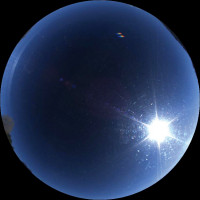Heads in the Clouds
Assistant Professor Jessica Kleiss and her students look to the clouds to improve climate change prediction.
by Oliver Baker
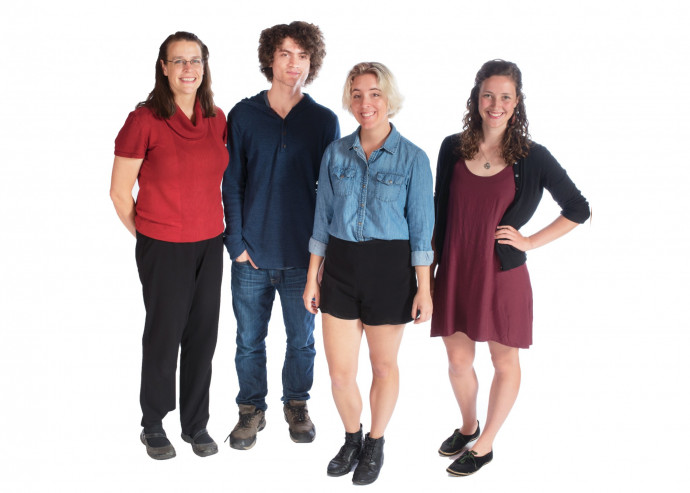
In a basement lab in the Olin Center for Physics and Chemistry, a small group of students and their professor huddle around a computer screen.
They watch as clouds dissipate, coalesce, swirl, and drift across the luminescent blue face of what looks like Earth from space but is actually a slice of sky nearly 2,000 miles away.
The cloud images, playing at fast-forward speed, were taken by a device called a Total Sky Imager, or TSI, located at the Southern Great Plains site of the federal government’s Atmospheric Radiation Measurement program in Oklahoma.
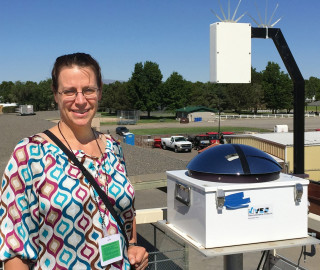
Sitting in a remote field, the TSI resembles an old-fashioned overhead projector in both size and shape.
“It’s capturing an image of the sky every 30 seconds … since 2001,” says Assistant Professor of Environmental Studies Jessica Kleiss, pausing to let the enormity of that fact sink in.
Chosen for its broad range of weather conditions, the Oklahoma site is home to a variety of sophisticated instruments designed to study cloud formation processes and their influence on global heat transfer.
Although scientists are rarely on site, they are able to access the site’s data 24/7 via an internet connection.
The TSI comes into play when a visual double check of data from other devices is needed.
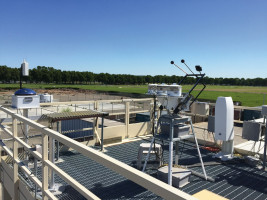
In fact, you could download a month or two of Oklahoma sky for yourself for free via the internet. It’s public data.
From Kleiss’ point of view, these accumulating images are like precious ore.
Their valuable contents, once she and her student researchers figure out how to extract them, will help to solve one of the biggest conundrums in climate change prediction: How will clouds respond to a warming Earth, and how will Earth respond to changing cloud cover?
Kleiss says that clouds could either accelerate global warming or slow it, depending on the types of clouds that form and their locations.
“The greenhouse effect is hugely modulated by clouds,” she says. On the one hand, high, wispy cirrus clouds foster warming, because they allow sunlight in and trap heat as the ground warms.
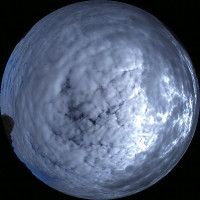
The impact of other cloud types is even more complicated.
Accurately predicting where, when, and what kind of clouds form is a challenge on two levels.
At the most superficial level, it’s just not possible to model the whole world’s climate in the detail needed to chart and follow individual clouds or even clusters of clouds.
Consequently, global modelers rely on cloud data they receive from other modelers who work on a finer scale, performing what are known as large-eddy simulations (LES).
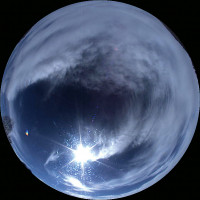
Here we arrive at the deeper challenge, which Kleiss and her students are addressing: It’s been impossible to rigorously test and validate the LES models for lack of comprehensive cloud measurements over large areas of sky.
* * *
Kleiss was not an atmospheric scientist when she came to Lewis & Clark in 2012.
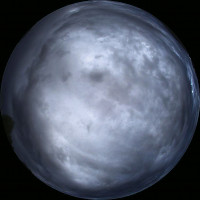
“My dissertation work at Scripps investigated wave breaking in the deep ocean,” says Kleiss.
“I also did postdoctoral work at the University of Washington with the Joint Institute for the Study of the Atmosphere and Ocean, where I studied the influence of the Gulf Stream on satellite observations of wind velocity over the ocean.”
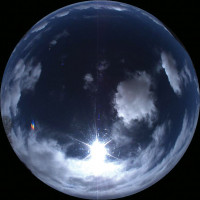
But the work required her to spend a lot of time in the field—often video recording waves from a research plane—which proved to be a constant logistical challenge.
“I came to realize it was a tough field to pursue as a liberal arts professor,” Kleiss says. “My passion and my heart lie in my classroom and my teaching. I needed to find my own niche.”
Her work on clouds came about serendipitously, Kleiss says. At a career workshop for new faculty in the earth sciences, she stood up to confide she was struggling to identify her next research project, and she mentioned her skills in image processing.
She heard a voice pipe up from across the room: “You’ve got image processing skills? We need to work together!”
That voice belonged to Tim Wagner, now an atmospheric scientist at the Cooperative Institute for Meteorological Satellite Studies/Space Science and Engineering Center at the University of Wisconsin at Madison.
Wagner had the notion that there was more to be made from cloud images captured by TSIs, and a collaboration was hatched merging Wagner’s atmospheric science skills with Kleiss’ image processing skills.
Kleiss and Wagner analyzed TSI images to show discrepancies between cloud cover measurements taken by laser devices known as ceilometers and observations historically made by humans.
This is concerning because ceilometers have replaced humans at weather stations throughout the country, and their data feeds into large-scale climatological studies, raising questions about their accuracy.
Kleiss and Wagner’s paper describing these findings was recently accepted for publication in the Journal of Atmospheric and Oceanic Technology.
* * *
Kleiss says the extra eyes, hearts, and minds of her students are essential to her project to repurpose TSI data.
This past summer, she worked with Laurel Garrett BA ’16, an environmental studies major with a minor in mathematics (who worked in Kleiss’ lab last summer as well); Makayla Keydel, a junior philosophy/mathematics double major; and William DeLee, a junior in mathematics.
All of them worked in her lab with support from the John S. Rogers Science Research Program.
Kleiss and her three students each separately inspected 3,600 images, one by one, in order to classify the types of clouds shown and flag any that were unusable.
The students are learning what it is to be a scientist, Kleiss says, and, in particular, they’re having an experience she didn’t enjoy herself until graduate school.
As an undergraduate at a big school, “you are at the bottom of the heap,” she says. “The grad students there say,
‘Yeah, we know this sucks—we had to do busy work too when we were undergrads. You won’t get to do the cool stuff until grad school.’”
At Lewis & Clark, the undergraduate research experience is entirely different.
“I look at what our students do here, and it’s amazing,” says Kleiss. For example, Garrett is coauthoring a paper with her.
To write a scientific journal article, a would-be author first needs to learn how to digest one, which is a skill all of Kleiss’ students have developed.
“Deciphering articles is more complex than anything I’ve had to do for a class,” says Keydel.
“There’s so much jargon you initially need to learn,” Garrett adds.
“I made a list of all of the acronyms,” Keydel says, laughing. “When I got to a page and a half, I gave up.”
In addition, all of them had to learn their way around a scientific programming interface called Matlab, with which they can perform elaborate statistical operations on their image data and apply functionalities such as “machine learning,” a basic form of artificial intelligence. Garrett, as a lab veteran and recent graduate, has helped show Keydel and DeLee the ropes.
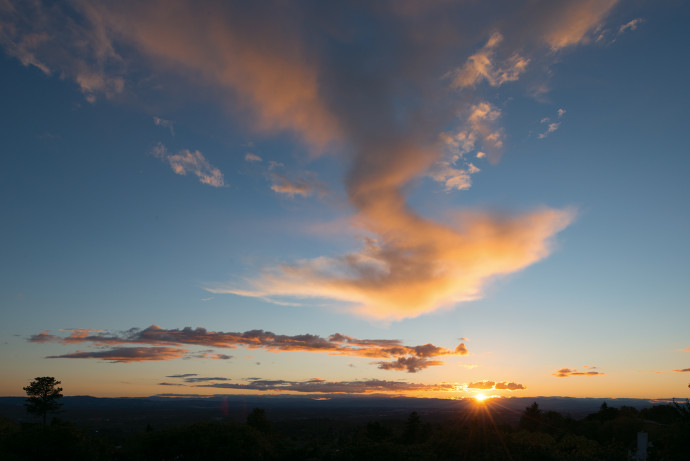
* * *
In their current work, Kleiss and her students use TSI images to classify and estimate the three-dimensional geometry of clouds.
“Our description of cloud geometry can be used to inform and validate weather and climate models,” says Kleiss.
The key will be software they’re developing to extract this information automatically.
To get at the geometrical information, the software leverages measurements other instruments on site have recorded at the same time.
John S. Rogers Science Research Program
This past summer, 65 Lewis & Clark students— including the students in Jessica Kleiss’ lab—took part in the John S. Rogers Science Research Program. This initiative is supported, in part, by the James F. and Marion L. Miller Foundation and works in partnership with Lewis & Clark’s Howard Hughes Medical Institute Undergraduate Science Education Program.
The Rogers program promotes collaborative research in the mathematical and natural sciences by providing the framework and financing for more than two dozen student-faculty projects each summer. It gives science majors a taste of real-world scientific investigation and helps them acquire skills they need to further their education and pursue a career in the sciences.
“Rogers fellows are treated as fledgling scientists who have a responsibility to communicate the purpose and results of their work to a general audience,” says Michael Broide, associate professor of physics and director of the program. “And when they go to graduate school,” he adds, “they hit the ground running.”
This data includes cloud altitude, size, elongation, thickness, and abundance across the wide expanse of air that the TSI camera captures over Oklahoma.
A more innovative element is a piece of software code they are cultivating through machine learning.
This is the algorithm that will identify cloud type—and so far is already able to distinguishes cirrus, cumulus, altocumulus, stratocumulus, stratus, and altostratus clouds.
Viewed from cloud height, the process isn’t as complicated as you might imagine.
For every pixel encoded within a digital image file, there are numbers to specify its balance and intensity of red, blue, and green.
By performing mathematical operations on the numbers, and by varying the operations, a piece of software can measure the image in a potentially limitless number of ways.
What the machine has to learn is which measurements best distinguish one type of cloud from another.
Garrett has been nurturing Matlab through this process.
She presents the software with a “training set” of images, on which it effectively imprints like a duckling to its mother—just through a huge amount of trial and error that it executes very quickly.
Then by administering a “test set,” Garrett learns what percentage of the time the software classifies clouds correctly.
Because TSI images are chronological, the automated information extraction will itself produce a chronology—a narrative of the detailed characteristics of real clouds across a large parcel of air as they evolve over time.
This is exactly what LES researchers need to evaluate their models, and the result will be global climate predictions in which scientists and policy makers can invest greater confidence.
As research subjects, Kleiss loves clouds largely for the same reason she loved waves, which she says is about scale and because, unlike atoms and black holes, they figure in human experience.
“That’s the thing right there that I study,” she says, pointing to some fluffy cumulus clouds hovering over the trees near Olin. “This is part of why I love earth science.”
Jessica Kleiss’ research is funded, in part, by a collaborative conservation grant from the Oregon Alliance of Independent Colleges & Universities; a natural sciences research program grant from the M.J. Murdock Charitable Trust; and, most recently, a collaborative grant from the U.S. Department of Energy.
Oliver Baker is a freelance science journalist in Portland.
More L&C Magazine Stories
Lewis & Clark Magazine is located in McAfee on the Undergraduate Campus.
MSC: 19
email magazine@lclark.edu
voice 503-768-7970
fax 503-768-7969
The L&C Magazine staff welcomes letters and emails from readers about topics covered in the magazine. Correspondence must include your name and location and may be edited.
Lewis & Clark Magazine
Lewis & Clark
615 S. Palatine Hill Road MSC 19
Portland OR 97219
